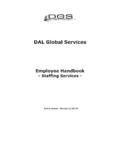Transcription of Hitachi Power Europe Service GmbH
1 Hitachi Power Europe Service is an independent subsidiary of Hitachi Group and bundles the Service activities of Hitachi Power Europe and ComponentsHitachi Power Europe Service GmbH2 About Hitachi Power Europe ServiceHitachi Power Europe Service GmbH (HPES), with about 300 employees, is an inter nationally active company in the field of Power generation, steam generator construction, as well as for environmental technologies and firing equipment. The company s head office is located in Duisburg (Germany), with the departments of engineering, boiler and firing technology, mills and components, erection and commissioning and flue gas cleaning. In addition, Hitachi Power Europe Service GmbH operates a centre of excellence for surface engineering (cladding) with a cooperation partner. With Service centres throughout Germany and branches in Europe , Middle East and Asia, Hitachi Power Europe Service GmbH operates as closely to its customers as possible, provid-ing its products and specialist Components in Typical Coal Power Plants 3 Mill Feeders 4 Pulverisers 6 Burn-Out Grate 13 Ash Removal 14 Other Ash Removal Components 15 Bevel Planetary Gear 16 Replacement Parts Service 17 References 18 Hitachi Power Europe Service GMBH Head office in Duisburg, Germany German locations International locationsMills and Components 3 Components in Typical Coal Power PlantsLignite Bituminous coal A Steam generatorB Steam linesC Coal bunker D Mill feederE Coal millF Burn-out grateG Ash removalH FD fana A Steam generatorB Steam linesC Coal bunker D Mill feederE Coal millF Ash removalG PA fanH FD fana 4 Mill FeedersReliability even under demanding requirementsDesigned as coal bunker dischargers.
2 The mill feeders supply the pulverisers with raw coal evenly dosed and in keeping with boiler load when faced with demanding requirements, the mill feeders designed by HPES operate both reliably and HPES staff determine the optimum feeder in keeping with the requested fuel quantity, design directives (including DIN EN 12952-9, NFPA 85 F) and customer requirements (for instance, volumetric and gravimetric metering).Other selection factors are the various bulk material properties, such as coal flow and erosion behaviour. Gravimetric coal feederMills and Components 5In hard coal boiler units, gravimetric coal feeders are used to discharge the raw coal from the bunker. In lignite plants, drag-chain conveyors together with belt conveyors are used to discharge the raw coal from the coal feedersThe gravimetric coal feeders with corrugated edge belt ensures high outputs, uniform bunker discharge and continuous mill charging even at low conveying rates.
3 This design permits volu-metric / gravimetric metering and quantities conveyed of up to 180 t / h. During normal operation no conveyed material can fall to the bottom of the feeder due to the design of the corrugated edge belt. Nevertheless a cleaning device is installed in the bottom section of the feeder to guarantee the removal of dust deposit. The belt speed is determined by the quantity conveyed. Purge air is supplied to the housing to stop condensate forming and, in turn, to stop corrosion. Drag-chain conveyorDrag-chain conveyors are meant for limited conveyed quantities of up to approx. 40 t / h this can, in special cases, be raised to 120 t / h. The fuel is discharged opposite to the direction of conveying. The drag-chain conveyor principle allows both a compact design with minimum spacing between bunker discharge and conveyor dumping as well as a possible large spacing between material charging and AADB CA Discharge of coal from the bunker B Conveyance of coalC Bed depth limitation D Conveyance of coalE Discharge to the millA Discharge of coal from the bunker B Conveyance of coalC Bed depth limitation D Weighing of coalE Discharge to the mill6 Pulverisers for Bituminous CoalExcellent resultsIn the mills, the raw coal is simultaneously pulverised, dried and evenly distributed to the coal burners.
4 Hot air or flue gases transfer the pulverised fuel to the burner and reduce the moisture in the coal. Bowl & roller mill type MPS The MPS bowl & roller mill by Hitachi Power Europe Service grinds and dries hard coals and difficult-to-grind lignite with a low moisture content to pulverised fuel and distributes them evenly directly to the burners. Mills of various sizes for throughputs ranging from 10 t/h to 200 t/h can be supplied. Constant refinements and improvements have led to excellent crushing results with high fineness grades from raw coal found throughout the world. The positive operating properties and low energy requirements have contributed in no small measure to the success of these mills. MPS millMills and Components 7 The performance of vertical spindle mills depends on the geometric dimensions, revolution speed of the grinding table and the grinding force itself. By suitable measures at existing plants capacity increase and adaption of the load change behavior are possible.
5 For example for changed coal characteristics. As a prerequisite for these mill upgrades, it needs to be ensured that sufficient primary air is available and that the mill primary air pressure as well as the mill drive Power have the required margins. This necessitates also investigating the mill motor, PA fans and pf-piping in of the above measures for variable adjustment of dust fineness during op-eration, by use of dynamic classifier (type SLS), also secures higher flexibility during load changes and a temporary increase of pulverised fuel outlet Standard SieveParticle Size in mV6 Passing (%)Residue R (%) rpm110 rpm10 0 rpm85 rpmSLS classifierA Rotary classifierB Classifier driveC Grinding rollersD Hydro-pneumatic systemE Grinding tableF GearG Motor a8 Pulverisers for Bituminous CoalLong Service lifeTube ball mill type RKD The Hitachi Power Europe Service RKD tube ball mill grinds and dries difficult-to-pulverise hard coals (particularly low-volatile coals such as lean coal and anthracite).
6 This mill type can deal with approx. 150 t / h of coal. Depending on size and space, the tube ball mill can be designed with drum or neck bearing and be of the single or double pass Rotary classifierB Oversize returnC Neck bearingD Drive gear rimE Grinding ball fillingF Feed spiral conveyorG Classifier riserRKD milla Mills and Components 9 Maintenance of tube ball millThe maintenance work at tube ball mills includes activities which are carried out while the mill is in operation and work which requires shutdown of the mill. Maintenance work during mill outage Inlet screw conveyors Inside lining of the inlet and outlet housing Grinding space armoring Air sealings installation of wear platesReplacement of screw spirals10 Low energy requirementsPulverising lignite is particularly challenging in view of its high moisture content and the considerable throughputs involved. Distributor fan beater mill type DGS HPES supplies DGS mills of various sizes up to a 240 t / h throughput for drying and pulver-ising raw lignite coals.
7 DGS technology involves the raw coal and flue gases being initially put through the pre-crushing beater section of the beater wheel. This ensures excellent air and coal dust distribu-tion into the beater wheel. Crushing in the DGS mill is usually so intensive that adequate grinding fineness can be obtained in one working operation without the need for an additional clas-sifier. This both raises the pressure balance and cuts back on energy re-quirements. The DGS mill has stood the test of time particularly with difficult-to-work lignites something that explains its considerable lifetime and unrivalled properties. a Pulverisers for LigniteA Flue gas gate valveB Inlet housingC Beater shaftD Beater wheelE CouplingF MotorG BearingDGS millMills and Components 11 Easy maintenanceWet fan mill type NV The NV mills ranging from 10 t/h to 140 t/h throu ghputs are for crushing high moisture content lignites for direct injection into the with the flue gases, the raw lignite is brought for crushing purposes into the beater wheel.
8 It acts as a fan impeller fitted with beater plates. Baffle-type classifiers ensure that the required fuel fineness for combus-tion is high-tech NV mill more than meets the ongoing demands worldwide of op-erational availability and low costs. a A Gate valve housingB Grinding chamber doorC Grinding chamberD Beater wheelE Baffle-type classifierF Double bearing G MotorNv mill12 Pulverisers for LigniteThe grinding system key component with huge refurbishment potentialOptimised grinding in terms of throughput and grinding fineness and in parallel minimisation of wear is the target of mill rehabilitations. Even without any firing upgrades, HPES has attained remarkable plant improvements which mainly have a positive impact on boiler operation a specialist for mills with its own technology, HPES possesses enormous competence in all kinds of mills and coals for new installations and upgrades the latter also for Non OEM mills.
9 HPES comprehensive knowledge on grinding and fluid dynamics within the mills / classifiers and their optimisation potential allows the company to improve matters through simple design measures backed up by CFD simulation. DGS mills, NV mills, N mills for ligniteThe main challenge behind a lignite mill upgrade is to optimise the contradictory targets of fuel throughput and grinding fineness in such a way that the increase of fuel throughput mostly in connection with improved grinding fineness can be obtained with a minimum of wear with consideration given to the permitted conditions (temperature, oxygen content).Efficient constructive measures either in the preheater section (for DGS mills), classifier (NV, N mills) or in the mill housing are HPES specialty for tapping the full potential of the mill again supported by CFD for HPES competence is the upgrade in Nicola Tesla A at fan mill DGS100S.
10 Instead of the requested contractual throughput increase of almost 10 %, the reasonable measures which HPES took resulted in a 30 % increaseMills and Components 13 Burn-Out Grate High efficienciesIn lignite coal or peat-fired plants with a high proportion of xylite or fibers in the fuel, the proportion of unburnt residue in the boiler hopper ash can be extremely high and this impairs firing optimum designed burn-out grate ensures that the ash burnout in the boiler hopper is improved to over 80 % thus substantially raising the overall efficiency of the boiler plant. In addition, afterburning results in additional heat input into the boiler hopper, which would otherwise be relatively cold. This leads to an even distribution of temperature in the jklmn iBurn-out grate diagramA Boiler furnace hopperB Refractory jacket of retarded combustion reactorC Water seal gasket D Firmly fixed grate supporting bars E Grate carriage F Grate surfaceG Hydraulic system for grate carriage and deashing flapH Ash hopperI Cooling and combustion air J Deashing flap K Ash discharge chuteL Shutoff gate valve in ash discharge chuteM DeasherN Monitoring system14 Ash RemovalSubmerged scraper conveyor functions.







